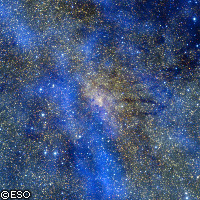Atlantic partnership emerges as black hole tears matter
Astronomers from Europe and the US have teamed together to study violent flares that are emanating from the super-massive black hole in the centre of the Milky Way. This is the first time that astronomers have simultaneously caught such a flare with their various specialised telescopes. In order to conduct concurrent observations, careful planning and coordination is required between the two teams and their devices. The observations will hopefully reveal a lot more about this intriguing sector in space. Deep in the depths of the Milky Way lies Sagittarius A*, otherwise referred to as Sgr A*. According to astronomers, this is a compact object approximately 26,000 light-years from Earth. Close observations of stars in this region have convincingly proven that Sgr A* must be a super-massive black hole with a mass of about four million times that of the Sun. Now, astronomers from Europe and the US have witnessed a flare emanating from the region of Sgr A*. These flares are thought to be gas thrown off by stars. They do not have the chance to travel far, as the gravitational pull is so strong that the flares enter an orbit before being sucked back into the black hole. Astronomers with the European Organisation for Astronomical Research in the Southern Hemisphere (ESO) have joined together with the Atacama Pathfinder Experiment (APEX) telescope to study light from Sgr A* at near-infrared wavelengths and the longer sub-millimetre wavelengths, respectively. Gunther Witzel, a PhD student from the University of Cologne in Germany, commented from his station at ESO's Very Large Telescope (VLT). 'At the VLT, as soon as we pointed the telescope at Sagittarius A, we saw it was active and getting brighter by the minute. We immediately picked up the phone and alerted our colleagues at the APEX telescope,' he said. Macarena García-Marín, also from Cologne, was waiting at APEX, where the observatory team had made a special effort to keep the instrument on standby. 'As soon as we got the call we were very excited and had to work really fast so as not to lose crucial data from Sgr A*. We took over from the regular observations, and were in time to catch the flares,' she explains. Over the next six hours, the team detected violently variable infrared emissions, with four major flares from Sgr A*. The submillimetre-wavelength results also showed flares but, crucially, this occurred about one and a half hours after the infrared flares. According to the University of Cologne's Andreas Eckart, who led the team, 'Observations like this, over a range of wavelengths, are really the only way to understand what's going on close to the black hole.' Both telescopes are located in Chile; their location in the southern hemisphere provides the best vantage point for studying the Galactic Centre. The simultaneous combination of the VLT and APEX telescopes has proved to be a powerful way to study the flares at multiple wavelengths. The team hopes that future observations will let them prove their proposed model, and discover more about this mysterious region at the centre of our Galaxy.
Countries
Chile, Germany, United States



